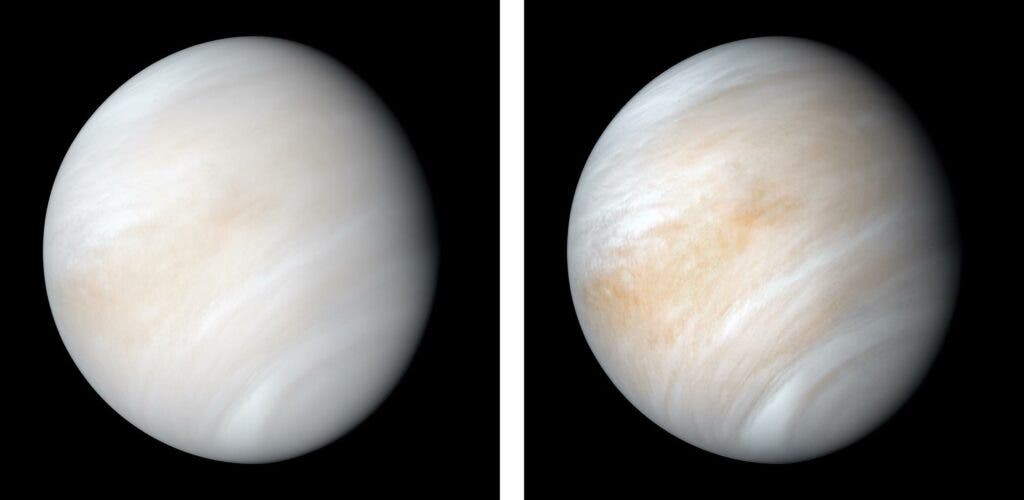Enthusiasm over a Venusian compound associated with life has been quenched by a new study. It’s probably just sulfur dioxide, researchers now believe.

Phosphine is a colorless, flammable, toxic gas compound — not something you’d be thrilled to see in most cases. But back in September, researchers got really excited about phosphine because it detected in the atmosphere of Venus.
For all its toxicity, phosphine can be produced by life. Finding phosphine on the hellish Venus suggests that life could perhaps exist on Venus, which understandably made a lot of astronomers very curious.
But right from the get-go, some were skeptical about the study. Just one month later, another group of researchers tried to find the phosphine themselves (using telescopes), but couldn’t. Two other groups reprocessed the same data used in the first study and also couldn’t find evidence for phosphine.
We’re not really sure what happened in the first study, but currently, the Nature page where the study is published reads:
“The authors have informed the editors of Nature Astronomy about an error in the original processing of the ALMA Observatory data underlying the work in this Article, and that recalibration of the data has had an impact on the conclusions that can be drawn. Nature Astronomy is working with the authors to resolve the matter.”
Now, a new study seems to put the final nail in the Venusian phosphine theory.
“Instead of phosphine in the clouds of Venus, the data are consistent with an alternative hypothesis: They were detecting sulfur dioxide,” said co-author Victoria Meadows, a UW professor of astronomy. “Sulfur dioxide is the third-most-common chemical compound in Venus’ atmosphere, and it is not considered a sign of life.”
Instead of looking for the phosphine in the telescope data, Meadows and colleagues tried a different approach: they created models of what could be observed on Venus. They found that sulfur dioxide can not only explain the observations, but is also consistent with what we already know of Venus.

The initial phosphine study used the Atacama Large Millimeter/submillimeter Array (ALMA) and the James Clerk Maxwell Telescope (JCMT) to make the observations, focusing on the 266.94 gigahertz frequency. Both phosphine and sulfur dioxide absorb radio waves close to this frequency. So what researchers observed could have been sulfur dioxide. The new study modelled how the signals would be picked up by the JCMT and ALMA telescopes.
“This is what’s known as a radiative transfer model, and it incorporates data from several decades’ worth of observations of Venus from multiple sources, including observatories here on Earth and spacecraft missions like Venus Express,” said lead author Andrew Lincowski, a researcher with the UW Department of Astronomy.
There’s another reason why the previous observations are very unlikely to be phosphine, researchers say: the initial signal was found not in the planet’s cloud layer, but far above it, where phosphine would likely be destroyed within seconds, but sulfur dioxide would be more stable.
“Phosphine in the mesosphere is even more fragile than phosphine in Venus’ clouds,” said Meadows. “If the JCMT signal were from phosphine in the mesosphere, then to account for the strength of the signal and the compound’s sub-second lifetime at that altitude, phosphine would have to be delivered to the mesosphere at about 100 times the rate that oxygen is pumped into Earth’s atmosphere by photosynthesis.”
The team also found that the ALMA antenna configuration had an unfortunate side effect: signals from gases like sulfur dioxide give off weaker signals than gases distributed over a smaller scale.
“They inferred a low detection of sulfur dioxide because of that artificially weak signal from ALMA,” said Lincowski. “But our modeling suggests that the line-diluted ALMA data would have still been consistent with typical or even large amounts of Venus sulfur dioxide, which could fully explain the observed JCMT signal.”
“When this new discovery was announced, the reported low sulfur dioxide abundance was at odds with what we already know about Venus and its clouds,” said Meadows. “Our new work provides a complete framework that shows how typical amounts of sulfur dioxide in the Venus mesosphere can explain both the signal detections, and non-detections, in the JCMT and ALMA data, without the need for phosphine.”
So where does this leave us? We know that Earth’s atmosphere contains small amounts of phosphine, and life may produce phosphine. At this point, it seems more likely that previous observations aren’t of phosphine. But venus also remains as mysterious and ever — with a toxic atmosphere, acidic clouds, and scorching hot temperatures, it’s not the place where you’d expect any life form to exist. Then again, we can’t say that for sure, either.
The study has been published in the journal Nature Astronomy.


